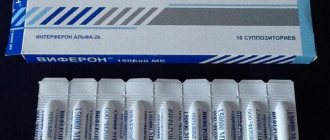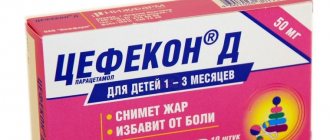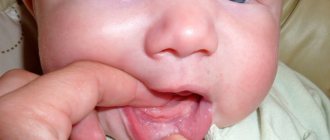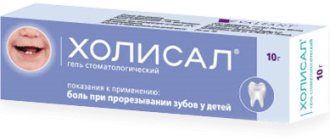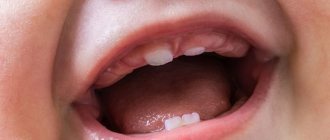“Viburkol” is a herbal preparation for relieving pain and inflammation when the first teeth appear
At the age of approximately 5-7 months, babies enter a difficult period - their first teeth begin to cut. For children, as well as for their parents, this stage turns into a serious test. And while some babies tolerate it more or less calmly, others experience obvious discomfort and severe pain, which they report by their whims, incessant crying and screams. During this period, the child may experience increased body temperature, cough, runny nose, and restless sleep. All this is a real stress not only for himself, but also for his worried mom and dad. In such cases, various pharmaceutical preparations and natural-based products come to the rescue, one of which is “Viburkol”, used for teething.
What is the drug "Viburkol"?
Viburkol is a suppository that has anti-inflammatory, soothing and antipyretic effects. They are mainly used by children, but sometimes pregnant women also take them.
The composition of one candle is as follows:
- pharmaceutical camomile;
- large plantain;
- belladonna or belladonna;
- meadow lumbago;
- bittersweet nightshade;
- calcium carbonate.
All of the above components are taken in homeopathic dilution, and inert pharmacologically solid fat is used as a basis. Since the fat base can melt at a temperature similar to body temperature, it is recommended to store the drug in the refrigerator or other place, and the air temperature should not exceed +25 ° C.
The homeopathic drug Viburkol helps ease teething in the baby
What happens in a baby's body when teeth begin to cut?
As mentioned above, the period of growth of the first milk teeth is associated with a certain stress for the child and is accompanied by some changes in his body. Obviously, there is a violation of the integrity of the gingival tissue, and this process, in turn, entails symptoms such as pain and burning in the area of eruption. Also, the child’s soft tissues of the oral cavity may become slightly red, and in some cases the cheeks may become slightly swollen. In addition, the body’s defenses are weakened, so many children simultaneously suffer from various infectious diseases.
Erupting the first teeth is a big challenge for a child.
And then the following happens: in order to minimize the risk of infection, the body begins to stimulate the production of saliva and interferon, which protects the child’s body and repels the attack of pathogenic bacteria1. This process is often accompanied by an increase in body temperature. Due to excessive salivation, slight irritation may appear on the chin and neck, and some disruptions in the functioning of the digestive system may occur - you should not be afraid of this, since all the child’s internal systems will normalize on their own as soon as teeth appear.
Experts do not recommend lowering the temperature during this period, but parents should still stock up on antipyretics in case of emergency. Currently, pharmacy shelves offer a wide range of drugs that help alleviate the baby’s condition during teething. According to reviews of Viburkol, this natural-based product really helps relieve severe inflammation and normalize the functioning of the digestive system.
Treatment of ARVI in children
Acute respiratory viral infections (ARVI) in children occupy a leading place among all infectious diseases. ARVIs are one of the most common diseases with which children consult a pediatrician and are hospitalized in an infectious diseases hospital. ARVI is recorded throughout the year, but the greatest number of diseases occurs from early autumn to late spring.
The prevalence of ARVI is associated with the presence of an extraordinary variety of respiratory pathogens, the formation of only type-specific post-infectious immunity and the ease of transmission of pathogens. It is impossible to fully take into account the true incidence of ARVI. Almost every person suffers from ARVI several times (from 4–8 to 15 times or more) a year. ARVI is especially common in young children. Children in the first months of life rarely get sick, since they are in relative isolation, and many of them retain for some time (up to 6 months) passive immunity received from the mother transplacentally with class G immunoglobulins. However, children in the first months of life can also suffer from acute respiratory viral infections, especially if they come into close (usually family) contact with sick people (most often the source of the infectious agent is the child’s mother). As a result of the disease, transplacental immunity may be weak or completely absent (primary - congenital forms of immunodeficiency) [7].
The highest incidence is observed among children from 2 to 5 years of age, which is usually associated with their visits to child care institutions and a significant increase in the number of contacts. A child attending kindergarten can get ARVI up to 10–15 times within 1 year, 5–7 times in the 2nd year, and 3–5 times a year in subsequent years. The decrease in incidence is explained by the acquisition of specific immunity as a result of acute respiratory viral infections. Frequent acute respiratory viral infections lead to a weakening of the body’s defenses, contribute to the formation of chronic foci of infection, cause allergization of the body, interfere with preventive vaccinations, aggravate the premorbid background, and delay the physical and psychomotor development of children [7].
Acute respiratory viral diseases represent an etiologically heterogeneous group. More than 200 types of viruses are known to cause ARVI, which makes diagnosis difficult. The cause of clinical manifestations can be various viruses - influenza, parainfluenza, rhinoviruses, adenoviruses, respiratory syncytial virus (RSV), metapneumovirus, reoviruses, coronaviruses, bocaviruses, as well as fungi, mycoplasma and chlamydia [1].
Children under 5 years of age and especially children in the first year of life are often hospitalized due to infection with RSV, influenza virus and parainfluenza. Rhinoviruses A and C often lead to severe acute respiratory viral infections in children under 5 years of age, especially with the development of obstructive bronchitis, bronchiolitis or the presence of bronchial asthma. ARVI pathogens are transmitted from person to person through airborne droplets, as well as through direct contact. The importance of contact transmission has been noted for rhinoviruses and RSV. The concept of a “cold,” which colloquially refers to a mild illness of the upper respiratory tract, is usually caused by a viral infection (usually rhinoviruses). The entry point for ARVI pathogens is the mucous membrane of the upper respiratory tract, where inflammation is localized in most ARVIs. However, some viruses (RSV, parainfluenza viruses, rhinoviruses, coronaviruses) affect not only the upper but also the lower respiratory tract, causing bronchitis, bronchiolitis and pneumonia, leading to severe ARVI, especially in young children [1].
Preferential tropism for one or another part of the respiratory tract, formed in the process of evolution, makes it possible to identify characteristic signs, which simplifies the differential diagnosis of the disease and allows timely prescription of etiotropic drugs. For example, with influenza, the inflammatory process occurs predominantly in the epithelium of the trachea and large bronchi, with respiratory syncytial infection - in the epithelium of bronchioles, rhinovirus infection - in the epithelium of the nasal cavity and paranasal sinuses, etc. [7].
In most cases, ARVI in children is not severe, so children are monitored on an outpatient basis. Children with severe and complicated forms of the disease, hyperthermic and convulsive symptoms, the development of toxicosis and hemorrhagic disorders, as well as children from socially disadvantaged families are subject to hospitalization.
The main directions of therapy for ARVI in the acute period are: etiotropic therapy using antiviral drugs, anti-inflammatory therapy, symptomatic treatment, as well as general therapeutic measures (bed rest, drinking plenty of fluids, a diet rich in vitamins). Antibacterial therapy is prescribed strictly according to indications.
Currently, the number of specific antiviral drugs approved for use in pediatrics is limited, so the emergence of each new drug with antiviral activity is welcomed. The main effect of antiviral drugs is to create an obstacle to the reproduction of viruses and reduce the viral load on the body. In addition, antiviral therapy facilitates the course of the disease, reduces the likelihood of complications and reduces the risk of infection to those around the patient. There is another reason why the creation of effective antiviral agents is complicated, namely the development of viral resistance to them. An example is the emergence of virus strains resistant to adamantane-type drugs [7].
All antiviral drugs are divided into three groups:
- drugs that directly affect the replication of viruses at various stages of their life cycle: adamantane derivatives, neuraminidase inhibitors (oseltamivir, zanamivir), RNA polymerase inhibitors (ribavirin);
- interferon drugs with antiviral and immunomodulatory effects;
- drugs-inducers of interferon (IF) production are high- and low-molecular compounds of natural and synthetic origin that stimulate the production of endogenous IF [6].
In the treatment of cough during ARVI, antitussive, expectorant and mucolytic drugs are used. Narcotic antitussives are not used in pediatric practice because they cause depression of the respiratory center and the development of addiction. Among non-narcotic drugs, butamirate citrate is used. In pediatrics, the need to use antitussives rarely arises due to the fact that they cause mucostasis, which contributes to the development of complications. Expectorants mainly based on medicinal plants (thermopsis extract, Lycorinum, marshmallow extract) are used in children for coughs with scanty, poorly discharged sputum. Mucolytic drugs (acetylcysteine, carbocysteine, ambroxol, bromhexine) effectively thin sputum without significantly increasing its quantity, increase the secretion of its liquid part, and stimulate the work of the ciliated epithelium [6, 7].
Bronchodilators are used for narrowing of the bronchial lumen in patients with obstructive syndrome due to ARVI, acute obstructive bronchitis or exacerbation of bronchial asthma due to ARVI. For this purpose, short-acting β2-agonists (salbutamol, fenoterol), anticholinergic drugs (Atrovent), and combination drugs (Berodual) are used. The inhalation form of drug administration is preferred [6].
Recently, a new generation of cough medications has appeared that inhibit inflammatory mediators, which include fenspiride. It has been proven that fenspiride reduces the manifestations of bronchospasm and inhibits the production of inflammatory mediators [4].
Local therapy for ARVI with rhinitis includes intranasal administration of a 0.9% sodium chloride solution, vasoconstrictor drops (oxymetazoline, xylometazoline, and for allergic rhinitis - intranasal sprays with a topical glucocorticoid [7].
Treatment of inflammatory diseases of the pharynx (pharyngitis, tonsillopharyngitis) includes anti-inflammatory drugs, local antiseptics, and immunomodulatory drugs.
Symptomatic therapy for ARVI is aimed at reducing the severity of certain clinical manifestations of the disease that interfere with the child’s well-being (fever, cough, sore throat, difficulty in nasal breathing, etc.). Fever is a protective reaction directed against the infectious agent. Under the influence of fever, the synthesis of interferons, primarily IFN-γ, TNF-α, increases, the bactericidal capacity of polynuclear cells and the reaction of lymphocytes to mitogen increases. “Feverish” cytokines enhance the synthesis of proteins in the acute phase of inflammation and stimulate leukocytosis. Fever reduces the ability to reproduce many microorganisms; there is a clear inverse relationship between the degree of increase in body temperature and the duration of excretion of microorganisms [3].
An increase in temperature stimulates a Th1-type immune response, which is necessary to activate a cellular response (macrophages and cytotoxic lymphocytes) that eliminates bacteria and virus-infected cells. The latter is especially important for infants, since fever accompanying infections plays an important role in switching the immune response from the Th2 type, which predominates at birth, to the more advanced Th1 type response [3].
The negative effects of fever are felt when the body temperature is closer to 41 ° C: metabolism, oxygen consumption (O2) and carbon dioxide (CO2) production increase sharply, fluid loss increases, and additional stress on the heart and lungs occurs. Initially, a healthy child tolerates these changes easily, although he experiences discomfort, but in children with pathology, fever can significantly worsen the condition. In particular, in children with damage to the central nervous system (CNS), fever contributes to the development of cerebral edema and seizures. With prolonged fever, fat reserves and muscles are depleted. Although these changes are quite serious, they quickly correct after the fever ends [3].
Increased body temperature in children is one of the main reasons for the uncontrolled use of various drugs in pediatric practice. For a differentiated approach to the therapeutic tactics of fever in children, it is advisable, depending on the clinical and anamnestic features, to distinguish two observation groups - initially healthy and a “risk group for the development of complications” [3].
The following children should be included in the risk group for the development of complications during febrile reactions:
- at the age of up to two months of life with a temperature above 38 °C;
- with a history of febrile seizures;
- with diseases of the central nervous system;
- with chronic pathology of the circulatory system;
- with hereditary metabolic diseases [1].
In cases where heat production corresponds to heat transfer, the child experiences a favorable, so-called “pink fever.” It got its name because of the color of the patient’s skin. In this case, the skin is moderately hyperemic, warm, and moist to the touch. The child’s behavior does not change practically against the background of this type of fever. In such cases, you should refrain from taking antipyretics if the temperature does not reach 39 °C. Drinking plenty of fluids is recommended, and physical cooling methods can be used. To enhance heat transfer, the child must be undressed and wiped with water at room temperature. There is no point in wiping the child with chilled vodka, alcohol or ice water, since a sharp decrease in body temperature can lead to vasospasm and a decrease in heat transfer. According to the recommendations of WHO specialists, antipyretic therapy for initially healthy children should be carried out at a body temperature of at least 39.0–39.5 °C [3, 5].
If, against the background of hyperthermia, the patient feels cold, chills, pale skin with a cyanotic tint to the nail beds and lips, cold extremities, and the increase in body temperature progresses, then this is a “pale” fever. In this case, tachycardia, shortness of breath, and possible convulsions are noted [5].
Children from the “risk group for the development of complications due to fever” require the prescription of antipyretic medications even with low-grade fever.
Antipyretic drugs (analgesics-antipyretics) are among the most commonly used drugs in medical practice. They are used to reduce the degree of fever, which is a protective reaction of the body. There are two groups of drugs:
- non-steroidal anti-inflammatory drugs - acetylsalicylic acid, metamizole sodium (Analgin), ibuprofen;
- paracetamol (acetaminophen) [5].
The drugs of choice for fever in children are paracetamol and ibuprofen. The mechanism of action of all antipyretics is to suppress the activity of cyclooxygenase (COX), a key enzyme in the synthesis of prostaglandins in the hypothalamus. This enzyme exists in the body in the form of two isoforms - COX-1, which has a cytoprotective effect on the mucous membrane of the gastrointestinal tract, and COX-2, which controls the excessive formation of pro-inflammatory prostaglandins. The anti-inflammatory effect of non-steroidal anti-inflammatory drugs is associated with the peripheral action of these drugs at the site of inflammation and local suppression of prostaglandin synthesis. Paracetamol, unlike these drugs, acts only centrally at the level of the hypothalamus [3].
Acetylsalicylic acid (Aspirin) is known as an effective analgesic and antipyretic, but its use in children under 15 years of age is contraindicated due to the risk of such a serious complication as Reye's syndrome. It is characterized by indomitable vomiting with the development of toxic encephalopathy and fatty degeneration of internal organs, mainly the liver and brain. In addition to Reye's syndrome, acetylsalicylic acid is characterized by other side effects associated with the blockade of the synthesis of protective prostaglandins E. These include gastrointestinal bleeding, aspirin-induced asthma and hypoglycemia. The use of Aspirin in newborns can lead to bilirubin encephalopathy [3].
The dose of paracetamol in children aged 3 months to 15 years is 10–15 mg/kg every 6 hours. Due to the central mechanism of action, paracetamol, unlike non-steroidal anti-inflammatory drugs, does not irritate the gastric mucosa, so it can be prescribed to children with bronchial obstruction. Contraindications to the use of paracetamol include:
- age up to 1 month;
- severe dysfunction of the liver and kidneys;
- deficiency of glucose-6-phosphate dehydrogenase;
- blood diseases.
Ibuprofen is used in a dose of 5 to 20 mg/kg per day. Ibuprofen, unlike paracetamol, has not only a central but also a peripheral effect, which is associated with its anti-inflammatory effect. In this regard, ibuprofen is used for infectious diseases that are accompanied by inflammation, hyperthermia and pain. Possible side effects include nausea, anorexia, gastrointestinal disorders, liver dysfunction, allergic reactions, anemia and thrombocytopenia, dizziness, and sleep disturbances [3].
In pediatric practice, the complex drug Viburkol has been successfully used for a long time, which is effectively used as a basic therapeutic agent for the treatment of restlessness with or without fever and the symptomatic control of common infections in children and infants. Viburkol/Viburkol N (suppositories and drops) are multicomponent bioregulatory drugs containing an optimally balanced combination of natural active ingredients in low dosages. In Russia, the drug is presented in one dosage form - suppositories [10].
Recommended regimen for using suppositories: for ARVI and painful symptoms of teething in children under 6 months, 1 suppository 2 times a day; children from 6 months with a body temperature above 37.5 ° C, 1 suppository 4 times a day; at body temperature above 38 °C, 1 suppository up to 6 times a day. When body temperature normalizes, take 1 suppository 1–2 times a day for another 3–4 days.
Viburcol has many benefits for infants and children with restlessness with or without fever and symptoms associated with common infections:
- proven reliable clinical effectiveness in general anxiety in infants and children and for the symptomatic treatment of common infections;
- can be used in conditions with or without fever;
- effective for all types of teething problems;
- effective for nightmares/fears;
- safe and rapid symptom relief;
- no known side effects, no known contraindications or interactions with other medications;
- individual dosage depending on need;
- supports the body's natural bioregulatory system;
- sold without a prescription;
- as effective as paracetamol (acetaminophen) in controlling symptoms of acute febrile infections in children;
- you can stop taking it at any time without a “withdrawal effect”;
- can be used immediately after birth;
- can be used in parallel with other drugs;
- safe and generally well tolerated;
- herbal ingredients;
- a safe, mild alternative to treatment with conventional drugs [8–10].
Currently, the evidence base for the effectiveness of Viburkol in clinical studies in children has been accumulated. For example, a multicenter prospective cohort study in children was conducted to investigate the effectiveness and tolerability of Viburcol N with paracetamol in the symptomatic treatment of acute febrile conditions in children under 12 years of age. Efficacy was assessed based on body temperature measurement (rectal), assessment of the child's severity by the doctor and parents, and objective examination data by the pediatrician. The study included a total of 767 patients who received Viburcol N (n = 361) or paracetamol (n = 406) as monotherapy. During the study, both treatment groups experienced equivalent and clinically significant improvements in body temperature, general well-being, severity of acute febrile infections, and severity of clinical symptoms. After 3 days, the temperature was significantly reduced in 87% of patients receiving Viburcol N, and after 4–7 days this figure increased to 96%. In both treatment groups, body temperature was reduced to normal levels (37 °C in the Viburcol N group and 36.9 °C in the paracetamol group) by the end of the observation period. Significant improvements (equal for both drugs) were achieved in all individual clinical symptoms. There was no statistical difference between the two treatment groups in terms of onset of efficacy [9].
Thus, it has been proven that Viburcol N effectively reduces the severity of the main symptoms of fever, the therapeutic potential of Viburcol N is comparable to the therapeutic potential of paracetamol, and the drug has a high safety profile.
In another non-randomized, multicentre, prospective cohort study conducted at 38 centers in Belgium in patients aged <11 years with fever due to acute respiratory viral infection, patients received either Viburcol drops or paracetamol. Patients were examined at the first visit and the last visit. The effectiveness of treatment was assessed by doctors based on the following indicators: fever, convulsions, anxiety, sleep disturbances, problems with eating and drinking. A total of 198 patients were evaluated (Viburcol n = 107, acetaminophen n = 91); the groups were well matched at the start of the study. The most common indications were: rhinitis (25%), bronchitis (22%), otitis media (18%) and/or tonsillitis (14%). Additional drugs were prescribed to 52.3% of patients in the Viburkol group and 65.9% in the paracetamol group. During the treatment period, both groups showed significant improvement in all measured variables. Viburkol met noninferiority criteria for all variables studied. A decrease in body temperature, accompanied by a decrease in fever, was observed in both groups: –1.7 ± 0.7 °C for Viburkol, –1.9 ± 0.9 °C for paracetamol.
Viburcol showed equal effectiveness compared to paracetamol in the study. In some cases, Viburcol was superior in terms of problems with eating and drinking, general assessment of the condition, and overall severity of infection [8].
In studies, Viburcol has proven itself to be a safe drug, but it should be taken into account that in patients with hypersensitivity to chamomile (Chamomilla) or the Asteraceae or Compositae family, suppositories can cause allergic reactions [10].
The duration of taking antipyretics should not exceed 1–2 days; in other cases, taking antipyretics may indicate the presence of a bacterial infection, which requires re-examination of the child.
Antibiotics are not indicated in most cases of acute respiratory viral infection. Unreasonable prescription of antibiotics contributes to increasing resistance of pathogenic bacteria that cause respiratory diseases. Indications for the prescription of antibiotics are bacterial complications of ARVI - acute otitis media, purulent sinusitis, bronchitis in the presence of purulent sputum, pneumonia, epiglottitis, as well as when fever persists above 38 °C for 3 days or more, with leukocytosis more than 15 × 109/l . The starting antimicrobial drugs for systemic action in these cases can be protected aminopenicillins (Amoxiclav, Augmentin) or macrolide drugs [1].
Thus, in the antipyretic therapy of acute respiratory viral infections, paracetamol and ibuprofen are currently used in pediatric practice. The bioregulatory drug Viburkol, available in the form of suppositories, has proven effectiveness in treating fever in children, comparable to paracetamol, and also has a high safety profile.
Literature
- Geppe N. A., Malakhov A. B. An integrated approach to the treatment and prevention of acute respiratory viral infections in children. Practical guide for doctors / Under. ed. prof. N. A. Geppe, prof. A. B. Malakhova. M., 2012. 47 p.
- Ilunina L. M., Kokoreva S. P., Makarova A. V. Feverish conditions in children: methodological recommendations. Voronezh: VSMA, 2008. 32 p.
- Feverish child. Diagnostic and treatment protocols. Clinical recommendations for pediatricians / Ed. ed. Baranova A. A., Tatochenko V. K., Bakradze M. D. 2nd ed., corrected. and additional M.: Pediatr, 2015. 321 p.
- Macharadze D. Sh., Yanaeva Kh. A., Peshkin V. I. ARVI. Features of treatment // Attending Physician. 2022. No. 11. pp. 38–41.
- Pediatrics. National leadership. Brief edition / Ed. Baranova A. A. M.: GEOTAR-Media, 2015. 768 p.
- Smirnova G.I. Frequently ill children - prevention and rehabilitation. M.: First Moscow State Medical University named after. I. M. Sechenova, 2012. 126 p.
- Shamsheva O. V. Influenza and ARVI in children. M.: GEOTAR-Media, 2022. 112 p.
- Derasse M. et al. The effects of a complex homeopathic medicine compared with acetaminophen in the symptomatic treatment of acute febrile infections in children: an observational study // Explore. 2005; 1 (1): 33–39.
- Müller-Krampe B., Gottwald R., Weiser M. Symptomatic Treatment of Acute Feverish Infections with a Modern Homeopathic Medication // International Journal for Biomedical Research and Therapy. 2002; 31 (2): 79–85.
- Biologische Heilmittel Heel GmbH. Monograph of the Viburkol product. 2011. 44 p.
L. V. Nikitina
GBUZ DGKB No. 9 named after. G. N. Speransky DZM branch No. 1, Moscow
Contact Information
Treatment of ARVI in children L. V. Nikitina For citation: Attending physician No. 6/2018; Page numbers in the issue: 44-48 Tags: children, etiotropic therapy, symptomatic therapy, bioregulatory drug
"Viburkol" - what kind of drug is it?
The drug in question belongs to the class of homeopathic remedies, produced by a German company. These are rectal suppositories, which are often used for young children during the eruption of their first milk teeth. However, this remedy helps relieve similar symptoms of many other childhood diseases.
According to experts in the field of pediatrics, this form of administration, namely suppositories, is the most preferable. This is a painless option for transferring medicinal substances into the body of a small child. Unlike tablets and capsules, suppositories do not provoke a gag reflex, and the active components of the drug are absorbed through the intestines much faster. In addition, “Viburkol” is a product created on the basis of plant components, so the harmful side effects are virtually reduced to zero.
Indications for use
According to the instructions for use, the drug "Viburkol" is effective in the following conditions:
- fevers of various etiologies,
- severe pain during the growth of the first teeth (recommended for children under 3 years of age),
- viral, fungal and bacterial infections,
- diseases of the genitourinary system,
- childhood dyspepsia - disruptions in the digestive tract, stomach pain, cramps and flatulence,
- mild disorders of the nervous system - anxiety syndrome, seizures and other symptoms.
Baby becomes restless when teething
Other medicines for teething -
As we said above, homeopathic medicines can only relieve moderately severe symptoms, and they do not have a pronounced analgesic, antipyretic or anti-inflammatory effect.
Therefore, in some cases, special anesthetic gels (for local use in the oral cavity) can be used in parallel. The gel may contain either only herbal components, or their combination with the mild anesthetic Lidocaine. But there are situations when all this is not enough. For example, your child may have a fever (24stoma.ru). In general, elevated temperature during teething occurs very rarely, and most often its cause is either a concomitant acute respiratory infection or herpetic stomatitis of the oral mucosa. Also, in some cases, the child may experience significant pain and inflammation of the gums. For these cases, the following drugs are available.
1) Children's Panadol for teething -
Children's Panadol contains paracetamol as an active component; accordingly, this drug will have a pronounced antipyretic and analgesic effect. There are several forms of release. Panadol suppositories with a dosage of 125 mg can be used from 1 year, and with a dosage of 250 mg - in children from 3 years. However, the most convenient form of release will be “Panadol Baby” (in the form of a suspension), which can be used in children from 3 months to 12 years.
Children's Panadol in suspension form –
What's included
The product in question contains only natural ingredients, and therefore has virtually no contraindications. Among the active ingredients of the drug:
- belladonna extract,
- pharmaceutical chamomile,
- bittersweet nightshade extract,
- plantain extract,
- calcium carbonate,
- meadow lumbago juice.
“When my son started teething, his temperature jumped, he had a runny nose - in short, the whole set. So, Viburkol helped us a lot. One candle was enough for the baby to fall asleep peacefully for the first time in a long time and not wake up all night! Therefore, I gave him this remedy for some time, and with it that terrible period passed easily and quickly. The temperature, however, was still there, but not as high as before using the suppositories.”
Alena D., Vladivostok, from correspondence on the women's forum
Chamomile, which is part of the drug, helps relieve inflammation.
Chamomile, which is part of the drug, helps relieve inflammation and reduce pain. Bittersweet nightshade fights infections in the body that cause fever. Belladonna also helps relieve inflammatory processes, but meadow lumbago is responsible for normalizing the functioning of the digestive and nervous systems. Plantain extract helps stop bleeding and reduce swelling.
How to give the drug to a child
Obviously, this herbal remedy really helps relieve acute symptoms, but how to give the drug to a child? Usually one candle 2-3 times a day is quite enough. In special situations, when the pain is too severe, more frequent use is allowed. In such cases, suppositories can be placed at intervals of half an hour, but the maximum duration of such intensive use of the drug is 2 hours.
It is recommended that a child under one year of age take half a candle twice a day. If a very young baby’s teeth begin to erupt, that is, in the first months of life, then in such situations experts allow the use of a quarter of a whole candle up to 4 times a day. It is better to discuss the exact dosage with your treating specialist.
On a note! How long does it take for Viburkol to work? As the active components of the drug are absorbed through the intestinal walls, they gradually reduce the temperature and pain. The sedative effect is usually observed half an hour after the introduction of the suppository, and the inflammation subsides only as a result of repeated use.
The use of the drug helps the child fall asleep peacefully
It is better to light a candle before bedtime - this way the child can get a good night’s sleep and rest. Keep in mind that when placing a suppository, there is still a risk of the drug leaking, especially if the child remains in an upright position. The product is also used for teething without fever, to relieve swelling, inflammation and pain.
What else can you give your baby to expose his condition?
Currently, there is simply no complete analogue of the drug “Viburkol” with the same composition. However, there are plenty of products in pharmacies that doctors allow to be used to alleviate the condition of children as their baby teeth grow. Below are the most popular options:
- based on paracetamol: “Cefekon” and “Efferalgan” - help lower the temperature and reduce pain,
- based on ibuprofen: “Nurofen” and “Ibufen” - also help reduce temperature and block pain,
- gels with anesthetic: “Dentinox” and “Kamistad” - for application to the gums to reduce pain.
If the baby's temperature has risen sharply, not rectal suppositories, but antipyretic drugs in the form of syrups will be more effective. As for local pain relievers, due to the immediate action of lidocoin, they give the desired effect faster than others. If the symptoms are too severe and the temperature exceeds the permissible norms, the child should be immediately shown to a doctor. And remember: any medications, even those based on natural ingredients, should be given to the baby only with the permission of a specialist.
- Elizarova, V.M. Trend in changes in the timing of the eruption of primary teeth in the modern generation of children, 2002.
Instructions for using "Viburkol"
Viburkol suppositories are used rectally. If you look at the candle more closely, you can see that it is slightly pointed at one end, and at the opposite end it has a small funnel-shaped depression. This form makes it easier to administer the drug.
We place the pad of the index finger in the recess, and with the thumb and middle finger we cover the candle in both directions. Gently spread the child’s buttocks with the other hand and in one movement quickly insert the candle into the anus forward with the pointed end. The drug must enter completely.
Sometimes the baby's buttocks are squeezed a little so that he cannot push the drug out. If everything is done correctly, then the baby will not feel any discomfort from such a procedure.

